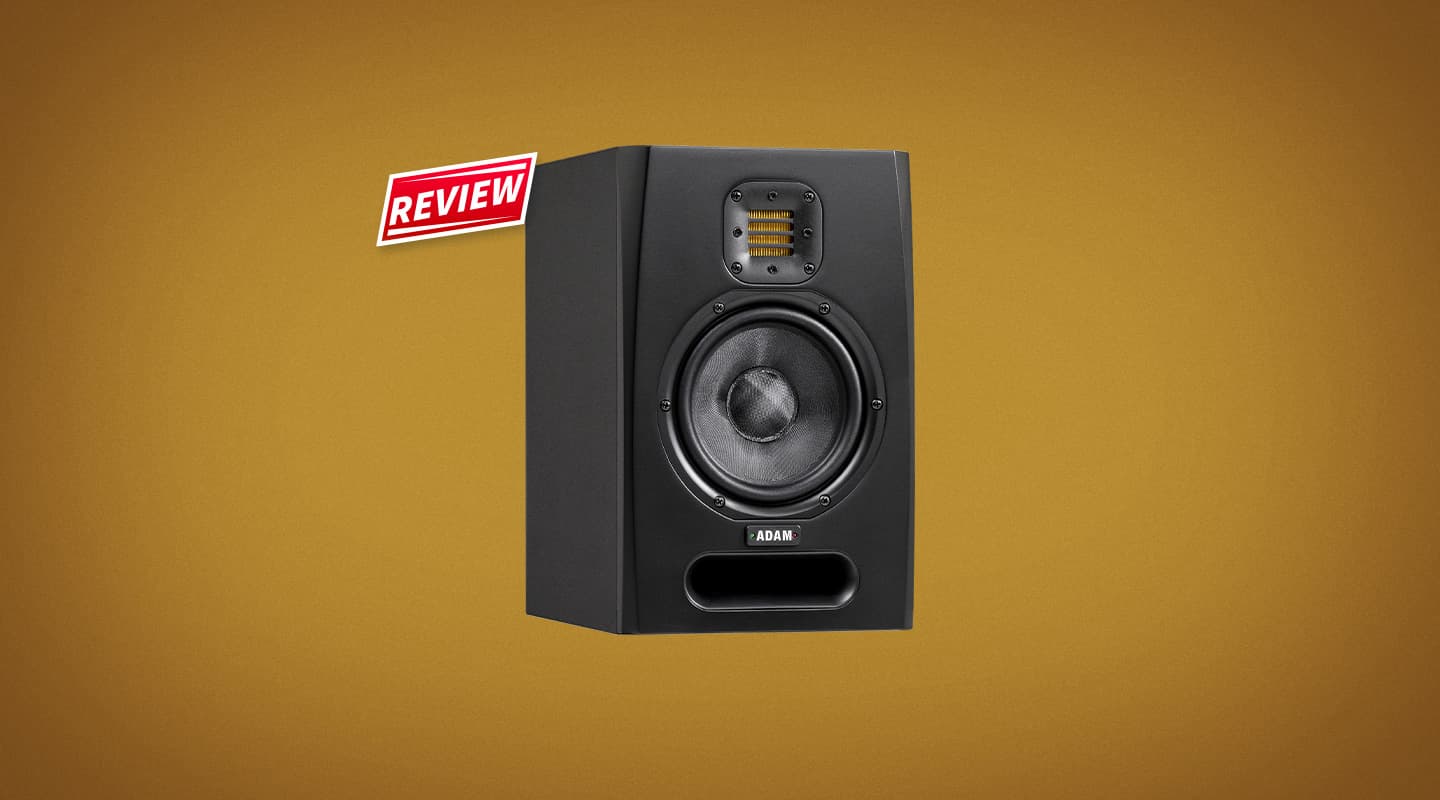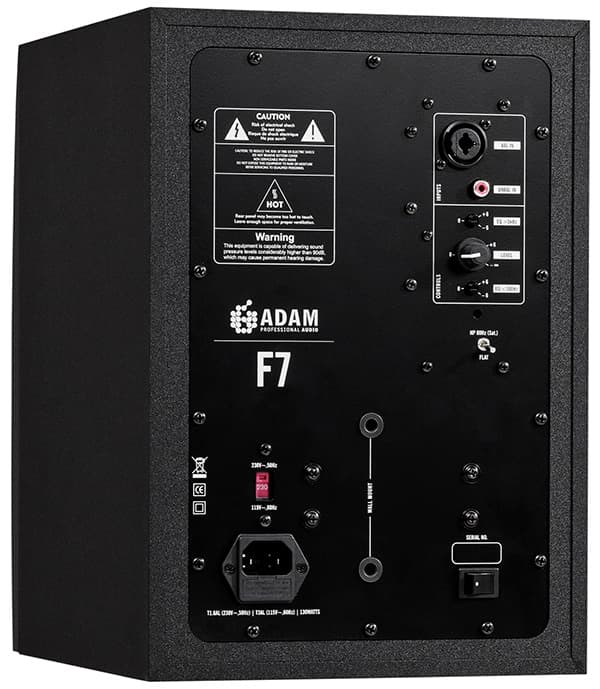
Review: Adam F-Series Active Nearfield Monitors
When you’re finding your feet in an over-crowded class of entry-level monitors, there’s nothing worse than having to live up to the A-grade reputation of an older sibling. For Adam’s latest offspring, early reports are in! So does F stand for Fabulous or Fail?
With their new F-series, Adam has added yet another layer to their pro-audio pile, and in doing so has given the inquisitive yet fiscally prudent musical minds of today one more in a long list of entry-level options. If this all seems a little familiar, it’s probably because it has been only two years since Adam brought ‘the more affordable’ AX series to market. Where the AX series was intended for, and has indeed become a staple of, the studio, The F-series is better suited to control bedrooms, mobile installs, edit bays or just next to the computer or TV for gaming. As a result, each F model comes in at only 60% the price of its corresponding AX antecedent.
The active monitor range comprises the F5, F7 and SubF — there’ll be no prizes for cracking this code. Unfortunately, for this review I had to do without the 8-inch, 110W PWM amplified sub. A real shame, as I’m sure for many the combination of nearfield and subwoofer would deliver the greatest bang for your buck. Adam certainly recommends it “wherever deeper and more powerful bass response is required.” The F5 features a 5-inch, 25W mid driver with carbon fibre/paper cone and a 25mm voice coil while, unsurprisingly, the F7 features a 7-inch, 60W driver with 37mm voice coil. Both mid-woofers have the general appearance of space age upholstery, as if some senile squillionaire had insisted on installing a chesterfield sofa in the back seat of his Bugatti Veyron.
ADAM’S RIBBON
The highs are reproduced in both models by a newly designed revision of the X-ART tweeter, designated simply the ART (Accelerating Ribbon Technology). For those of you who’ve been living in a cave in Tora Bora, the ribbon tweeter may as well be Adam’s fingerprint; appearing in all of its designs. The tweeter employs a pleated ribbon which pushes the air in and out of its folds as the spaces between them expand and contract in response to the audio signal. Sort of like an accordion. According to Adam, this design produces flawless transient reproduction. The F-series tweeter has only 3/4 the surface area of the AX design and slightly less efficiency but we’re assured performance has been maintained. The drivers are bi-amped by a pair of continuous output Class AB power amps optimised for their associated drivers.
The magnetically-shielded cabinets employ a front ported design, with a flattened bell-shaped vent, the approximate width of the mid-driver. Although not as marked as the AX models, the edges of the baffle are bevelled to reduce edge diffraction. While the F5 is slightly larger that the A5X, the F7 is significantly smaller than its counterpart. At 6.8 and 9kg respectively they’re also solid without feeling heavy. On the rear panels both models share an identical layout. A fused IEC input to the switch-mode power supply, with voltage selector, power switch, TRS/XLR combo connector for balanced audio input and RCA for unbalanced. Both inputs have the same sensitivity but the RCA will override the combo input when connected. A volume pot (-∞ to +6dB, with a detent at 0dB) and smaller centre-detented trim pots are provided for High (5kHz, ±6dB @20kHz) and Low (300Hz, ±6dB @100Hz) shelving filters while a switchable 80Hz high-pass filter is included; primarily for use when pairing with the SubF. Handily, two metric M6 (6mm) mounting threads have been provided for stand or wall mounting. Both models feature signal sensing circuitry and a standby power-saving mode which activates approximately 20 minutes after the last signal has been detected. On restart they take a few seconds to switch back on so don’t keep turning up that master fader. Built-in thermal protection will also mute the outputs if the back panel temperatures exceed unsafe limits. While they certainly get warm and feature no external heat sink, I tested both sets throughout most of Melbourne’s recent scorchers, in a studio sans air-con, and never had any issues.
NEED TO KNOW
AURAL EXAM
After a period of run in, I was initially struck by the top-end of both the F5 and F7. Switching between my usual setup (Quested VS2108, Yamaha NS10M/Crown DC300A, Avantone MixCube/Crown D150A) and the Adams felt like I’d engaged a boosted high frequency shelf. Not in a harsh, edgy way and not like pulling a blanket off the speakers but somewhere in between. This was clearly my first experience of the ART of Adam. It actually took me a few days to adjust. What at first felt extreme settled to feel detailed and revealing. Vocal sibilance felt as if it was being highlighted and by the end of the test period I was valuing their representation of the breathy detail on instruments like soprano saxophone. Despite this, I wouldn’t necessarily describe them as being open sounding. They had detail, but mixes with real depth sounded flat by comparison with the far more expensive Questeds and the further you tried to hear into the spaces the blurrier things became. Frankly, at their price point this is hardly surprising.
Both the F5 and F7 also suffered from a modern nearfield condition that seems to plague many designs and has been noted in these pages by a number of reviewers. While even the 5-inch model produced remarkably deep low end content with reasonable accuracy the overall effect was to destabilise the picture, disconnecting the bottom from the mid-range. I far preferred both with their 80Hz HPF engaged, I only wished a second position had been included at 50 or 45Hz. Experiments in different environments and with different mounting positions using a 48dB/octave filter cutting the source below 45Hz all showed significant improvements.
The F5 and F7 do exhibit some key differences. While the F7 is obviously capable of greater bass extension and therefore just sounds bigger, it was also able to better cope with the demands of larger and less dynamic mixes. In many ways I preferred the performance of the F5 on sparse acoustic material but as layers were added things quickly became less defined. If you’re making heavy rock or banging hip hop you’ll likely feel the F7 to be your only choice. The two however differ in their upper midrange voicing and I found myself vacillating in my preference depending on the source material. Neither however gave me the midrange articulation I was chasing when listening to the electric guitars on something like Radiohead’s In Rainbows. The rear panel controls do allow for some tailoring to your own environment and preferences but in general I was comfortable with these settings left flat. I would have preferred a more restrained ±3dB on all filters using calibrated switches rather than the undetented pots to ensure that matched settings could be ensured between multiple units. The same went for the volume pots which I left at their notched mid point.
When you consider what some of us (by which of course I mean me) have spent on real-world reference monitors over the years (Yamaha NS-10M, Auratone etc), the current crop of entry-level active monitors are exceptionally good value. Nevertheless, it’s important to remember that with value does come compromise. If required, I could work happily with a pair of the F7s, even with their shortcomings; but with a $1099 price tag only $150 below that of the A5X, I’d be inclined to either haggle or spend that little bit extra. Especially when you factor in the additional three years of warranty (five years in total) offered with the AX series. On the other hand, the F5 more closely fits the prosumer brief and I can definitely see it being a viable solution to any number of installation requirements. F may only stand for fair, but for most that will be perfectly fine!

















RESPONSES